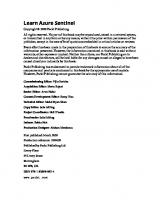Hands-On Networking with Azure: Build large-scale, real-world apps using Azure networking solutions 9781788998222, 1788998227
A step-by-step guide to get you up and running with Azure Networking Services and help you build solutions that leverage
146 72 6MB
English Pages 276 [270]
Table of contents :
Cover
Title Page
Copyright and Credits
Dedication
Packt Upsell
Contributors
Table of Contents
Preface
Chapter 1: Azure Virtual Networks 101
Introduction
Learning outcomes
Technical requirements
Introduction to Microsoft Azure Networks
Azure terminologies
ASM versus ARM model
Azure portal (ARM model)
ARM key points
Azure VNet
Azure VNet benefits
Creating Azure VNet
Adding address spaces to the virtual network
Adding subnets to the virtual network
Azure VNet key points
Automating your tasks
Azure PowerShell
Installing the Azure PowerShell module
Installing the Azure PowerShell module from PowerShell Gallery
Creating a virtual network in Azure portal using PowerShell
Adding address space to a virtual network using PowerShell
Azure CLI
Installing Azure CLI 2.0
Creating a virtual network using Azure CLI 2.0
Adding a gateway subnet to a virtual network using Azure CLI 2.0
Adding an address space to a virtual network using Azure CLI 2.0
Summary
Questions
Further reading
Chapter 2: Delving into Azure Virtual Networks
Introduction
Learning outcomes
Understanding Azure VNet architecture
Azure VNet service endpoints
Why use VNet service endpoints?
Configuring service endpoints for Azure VNet
Azure VNet service endpoints key points
Azure services integration with virtual networks
Integrating Azure services with Azure VNet key benefits
Virtual network peering
Configuring virtual network peering
Virtual network peering key points
Securing Azure VNet
NSG
Creating NSG
Inbound security rules
Outbound security rules
Associating the NSG
Associating the NSG to an NIC
Associating the NSG to a subnet
Azure DDoS protection
Automating the tasks
Adding a service endpoint to an existing virtual network using PowerShell
Adding a service endpoint to an existing virtual network using Azure CLI
Creating virtual network peering using PowerShell
Creating virtual network peering using Azure CLI
Creating NSG using PowerShell
Creating NSG using Azure CLI
Associating NSG with a subnet using PowerShell
Associating NSG with a subnet using Azure CLI
Summary
Questions
Further reading
Chapter 3: Azure Network for VMs
Introduction
Learning outcomes
Azure VMs
Azure VMs series
Azure VMs statuses
Creating and configuring Azure VMs
Azure VMs networking
Adding inbound and outbound rules
Adding an additional NIC to the VM
Configuring the NICs
Azure VNets considerations for Azure VMs
Automating tasks
Creating an Azure VM using Azure PowerShell
Creating an Azure VM using Azure CLI 2.0
Adding an inbound or outbound rule to an Azure VM using Azure PowerShell
Adding an inbound or outbound rule to an Azure VM using Azure CLI 2.0
Attaching an NIC to an Azure VM using Azure PowerShell
Attaching an NIC to an Azure VM using Azure CLI 2.0
Enabling IP forwarding using Azure PowerShell
Enabling IP forwarding using Azure CLI 2.0
Adding an additional IP address using Azure PowerShell
Adding an additional IP address using Azure CLI 2.0
Summary
Questions
Further information
Chapter 4: Network Connectivity Scenarios in Azure
Introduction
Learning outcomes
Network connectivity scenarios in Azure
VNet2VNet connection
VNet2VNet connection benefits
Creating a VNet2VNet connection
VNet2VNet connection key points
Point-to-Site connection
Point-to-Site connection advantages
Creating a Point-to-Site connection
Point-to-Site connection key points
Site-to-Site connection
Site-to-Site connection benefits
Creating a Site-to-Site connection
Site-to-Site connection key points
ExpressRoute
ExpressRoute benefits
ExpressRoute connectivity models
Co-location at a cloud exchange
Point-to-Point Ethernet connection
Any-to-any (IPVPN) connection
User-defined routes
Creating a user-defined route
User-defined routing key points
Summary
Questions
Further information
Chapter 5: Azure DNS
Introduction
Learning outcomes
Azure DNS
Azure DNS benefits
Azure DNS zones and records
Creating a DNS zone
Creating a DNS record
DNS zones and records key points
Azure DNS delegation
Configuring DNS delegation for third-party domain names
Configuring DNS delegation for subdomains
Azure DNS delegation key points
Azure reverse DNS zone
Azure reverse DNS zone key points
Private Azure DNS zones
Private Azure DNS zones key points
Automating the tasks
Creating an Azure DNS zone using PowerShell
Creating an Azure DNS zone using Azure CLI 2.0
Creating an Azure DNS record using PowerShell
Creating an Azure DNS record using Azure CLI 2.0
Configuring Azure DNS delegation using PowerShell
Configuring Azure DNS delegation using Azure CLI 2.0
Creating an Azure reverse DNS zone using PowerShell
Creating an Azure reverse DNS zone using Azure CLI 2.0
Creating a PTR record using PowerShell
Creating a PTR record using Azure CLI 2.0
Summary
Questions
Further information
Chapter 6: Azure Load Balancers
Introduction
Learning outcomes
Introduction to Azure Load Balancer
Azure Load Balancer benefits
Azure Load Balancer flavors
Basic Azure Load Balancer
Standard Azure Load Balancer
Standard Azure Load Balancer benefits
Public Azure Load Balancer
Internal Azure Load Balancer
Hands-on with Azure Load Balancers
Creating a public Azure Load Balancer
Creating an internal Azure Load Balancer
Configuring public load balancer frontend IPs
Creating a public IP address
Add additional frontend IP
Configuring internal load balancer frontend IPs
Configuring the load balancer backend pools
Configuring load balancer health probes
Configuring load balancing rules
Configuring inbound NAT rules
Summary
Questions
Further information
Chapter 7: Azure Traffic Manager
Introduction
Learning outcomes
Introduction to Azure Traffic Manager
Why Azure Traffic Manager?
Azure Traffic Manager endpoints
Azure Traffic Manager routing methods
Creating Traffic Manager profile
Traffic Manager configuration
Configuring Traffic Manager service endpoints
Configuring endpoints for Traffic Manager with performance routing method
Adding an Azure endpoint
Adding an external endpoint
Adding a nested endpoint
Configuring endpoints for Traffic Manager with the geographic routing method
Configuring endpoints for Traffic Manager with the priority routing method
Configuring endpoints for Traffic Manager with the weighted routing method
Azure Traffic Manager key points
Automating the tasks
Creating a Traffic Manager profile using Azure PowerShell
Creating a Traffic Manager profile using Azure CLI 2.0
Adding an Azure endpoint using Azure PowerShell
Adding an Azure endpoint using Azure CLI 2.0
Adding an external endpoint using Azure PowerShell
Adding an external endpoint using Azure CLI 2.0
Adding a nested endpoint using Azure PowerShell
Adding a nested endpoint using Azure CLI 2.0
Summary
Questions
Further information
Chapter 8: Azure Application Gateway
Introduction
Learning outcomes
An introduction to Azure Application Gateway
Why Azure Application Gateway?
The flavors of Azure Application Gateway
Creating an Azure Application Gateway
Configuring Azure Application Gateway settings
Azure Application Gateway configurations
Configuring WAF
Configuring the backend pool
Configuring Azure Application Gateway HTTP settings
Configuring frontend IP configurations
Configuring listeners
Configuring basic listener
Configuring multi-site listener
Configuring rules
Configuring basic rule
Configuring path-based rule
Configuring health probes
Summary
Questions
Further reading
Other Books You May Enjoy
Index
Cover
Title Page
Copyright and Credits
Dedication
Packt Upsell
Contributors
Table of Contents
Preface
Chapter 1: Azure Virtual Networks 101
Introduction
Learning outcomes
Technical requirements
Introduction to Microsoft Azure Networks
Azure terminologies
ASM versus ARM model
Azure portal (ARM model)
ARM key points
Azure VNet
Azure VNet benefits
Creating Azure VNet
Adding address spaces to the virtual network
Adding subnets to the virtual network
Azure VNet key points
Automating your tasks
Azure PowerShell
Installing the Azure PowerShell module
Installing the Azure PowerShell module from PowerShell Gallery
Creating a virtual network in Azure portal using PowerShell
Adding address space to a virtual network using PowerShell
Azure CLI
Installing Azure CLI 2.0
Creating a virtual network using Azure CLI 2.0
Adding a gateway subnet to a virtual network using Azure CLI 2.0
Adding an address space to a virtual network using Azure CLI 2.0
Summary
Questions
Further reading
Chapter 2: Delving into Azure Virtual Networks
Introduction
Learning outcomes
Understanding Azure VNet architecture
Azure VNet service endpoints
Why use VNet service endpoints?
Configuring service endpoints for Azure VNet
Azure VNet service endpoints key points
Azure services integration with virtual networks
Integrating Azure services with Azure VNet key benefits
Virtual network peering
Configuring virtual network peering
Virtual network peering key points
Securing Azure VNet
NSG
Creating NSG
Inbound security rules
Outbound security rules
Associating the NSG
Associating the NSG to an NIC
Associating the NSG to a subnet
Azure DDoS protection
Automating the tasks
Adding a service endpoint to an existing virtual network using PowerShell
Adding a service endpoint to an existing virtual network using Azure CLI
Creating virtual network peering using PowerShell
Creating virtual network peering using Azure CLI
Creating NSG using PowerShell
Creating NSG using Azure CLI
Associating NSG with a subnet using PowerShell
Associating NSG with a subnet using Azure CLI
Summary
Questions
Further reading
Chapter 3: Azure Network for VMs
Introduction
Learning outcomes
Azure VMs
Azure VMs series
Azure VMs statuses
Creating and configuring Azure VMs
Azure VMs networking
Adding inbound and outbound rules
Adding an additional NIC to the VM
Configuring the NICs
Azure VNets considerations for Azure VMs
Automating tasks
Creating an Azure VM using Azure PowerShell
Creating an Azure VM using Azure CLI 2.0
Adding an inbound or outbound rule to an Azure VM using Azure PowerShell
Adding an inbound or outbound rule to an Azure VM using Azure CLI 2.0
Attaching an NIC to an Azure VM using Azure PowerShell
Attaching an NIC to an Azure VM using Azure CLI 2.0
Enabling IP forwarding using Azure PowerShell
Enabling IP forwarding using Azure CLI 2.0
Adding an additional IP address using Azure PowerShell
Adding an additional IP address using Azure CLI 2.0
Summary
Questions
Further information
Chapter 4: Network Connectivity Scenarios in Azure
Introduction
Learning outcomes
Network connectivity scenarios in Azure
VNet2VNet connection
VNet2VNet connection benefits
Creating a VNet2VNet connection
VNet2VNet connection key points
Point-to-Site connection
Point-to-Site connection advantages
Creating a Point-to-Site connection
Point-to-Site connection key points
Site-to-Site connection
Site-to-Site connection benefits
Creating a Site-to-Site connection
Site-to-Site connection key points
ExpressRoute
ExpressRoute benefits
ExpressRoute connectivity models
Co-location at a cloud exchange
Point-to-Point Ethernet connection
Any-to-any (IPVPN) connection
User-defined routes
Creating a user-defined route
User-defined routing key points
Summary
Questions
Further information
Chapter 5: Azure DNS
Introduction
Learning outcomes
Azure DNS
Azure DNS benefits
Azure DNS zones and records
Creating a DNS zone
Creating a DNS record
DNS zones and records key points
Azure DNS delegation
Configuring DNS delegation for third-party domain names
Configuring DNS delegation for subdomains
Azure DNS delegation key points
Azure reverse DNS zone
Azure reverse DNS zone key points
Private Azure DNS zones
Private Azure DNS zones key points
Automating the tasks
Creating an Azure DNS zone using PowerShell
Creating an Azure DNS zone using Azure CLI 2.0
Creating an Azure DNS record using PowerShell
Creating an Azure DNS record using Azure CLI 2.0
Configuring Azure DNS delegation using PowerShell
Configuring Azure DNS delegation using Azure CLI 2.0
Creating an Azure reverse DNS zone using PowerShell
Creating an Azure reverse DNS zone using Azure CLI 2.0
Creating a PTR record using PowerShell
Creating a PTR record using Azure CLI 2.0
Summary
Questions
Further information
Chapter 6: Azure Load Balancers
Introduction
Learning outcomes
Introduction to Azure Load Balancer
Azure Load Balancer benefits
Azure Load Balancer flavors
Basic Azure Load Balancer
Standard Azure Load Balancer
Standard Azure Load Balancer benefits
Public Azure Load Balancer
Internal Azure Load Balancer
Hands-on with Azure Load Balancers
Creating a public Azure Load Balancer
Creating an internal Azure Load Balancer
Configuring public load balancer frontend IPs
Creating a public IP address
Add additional frontend IP
Configuring internal load balancer frontend IPs
Configuring the load balancer backend pools
Configuring load balancer health probes
Configuring load balancing rules
Configuring inbound NAT rules
Summary
Questions
Further information
Chapter 7: Azure Traffic Manager
Introduction
Learning outcomes
Introduction to Azure Traffic Manager
Why Azure Traffic Manager?
Azure Traffic Manager endpoints
Azure Traffic Manager routing methods
Creating Traffic Manager profile
Traffic Manager configuration
Configuring Traffic Manager service endpoints
Configuring endpoints for Traffic Manager with performance routing method
Adding an Azure endpoint
Adding an external endpoint
Adding a nested endpoint
Configuring endpoints for Traffic Manager with the geographic routing method
Configuring endpoints for Traffic Manager with the priority routing method
Configuring endpoints for Traffic Manager with the weighted routing method
Azure Traffic Manager key points
Automating the tasks
Creating a Traffic Manager profile using Azure PowerShell
Creating a Traffic Manager profile using Azure CLI 2.0
Adding an Azure endpoint using Azure PowerShell
Adding an Azure endpoint using Azure CLI 2.0
Adding an external endpoint using Azure PowerShell
Adding an external endpoint using Azure CLI 2.0
Adding a nested endpoint using Azure PowerShell
Adding a nested endpoint using Azure CLI 2.0
Summary
Questions
Further information
Chapter 8: Azure Application Gateway
Introduction
Learning outcomes
An introduction to Azure Application Gateway
Why Azure Application Gateway?
The flavors of Azure Application Gateway
Creating an Azure Application Gateway
Configuring Azure Application Gateway settings
Azure Application Gateway configurations
Configuring WAF
Configuring the backend pool
Configuring Azure Application Gateway HTTP settings
Configuring frontend IP configurations
Configuring listeners
Configuring basic listener
Configuring multi-site listener
Configuring rules
Configuring basic rule
Configuring path-based rule
Configuring health probes
Summary
Questions
Further reading
Other Books You May Enjoy
Index

- Author / Uploaded
- Mohamed Waly



![Azure Networking Cookbook [2 ed.]
9781800563759](https://ebin.pub/img/200x200/azure-networking-cookbook-2nbsped-9781800563759-i-7440743.jpg)
![Azure Networking Cookbook [2 ed.]
9781800563759](https://ebin.pub/img/200x200/azure-networking-cookbook-2nbsped-9781800563759.jpg)




